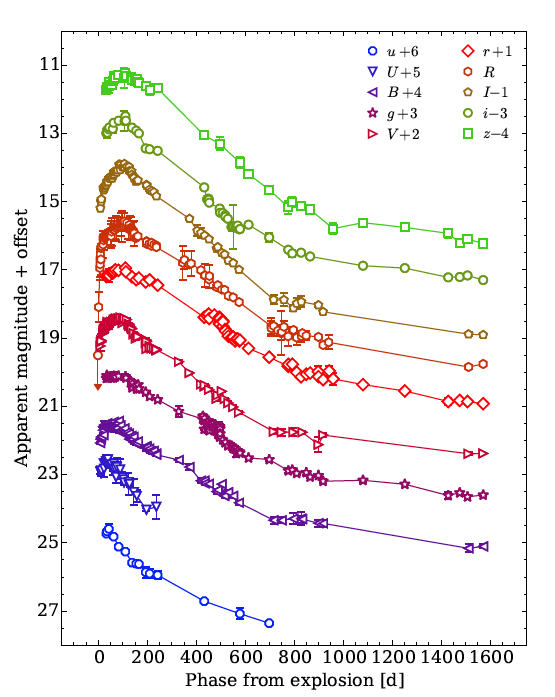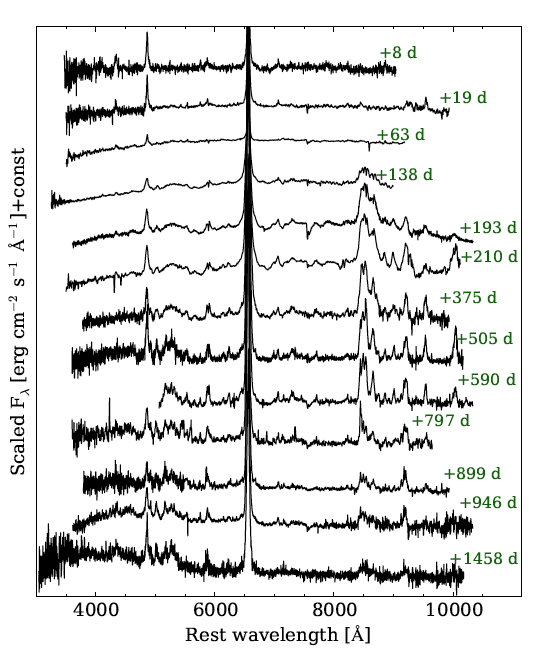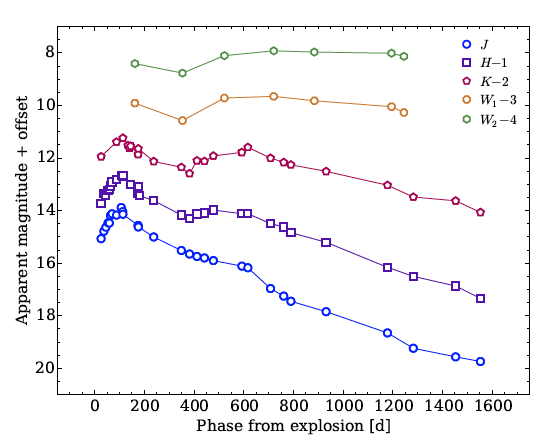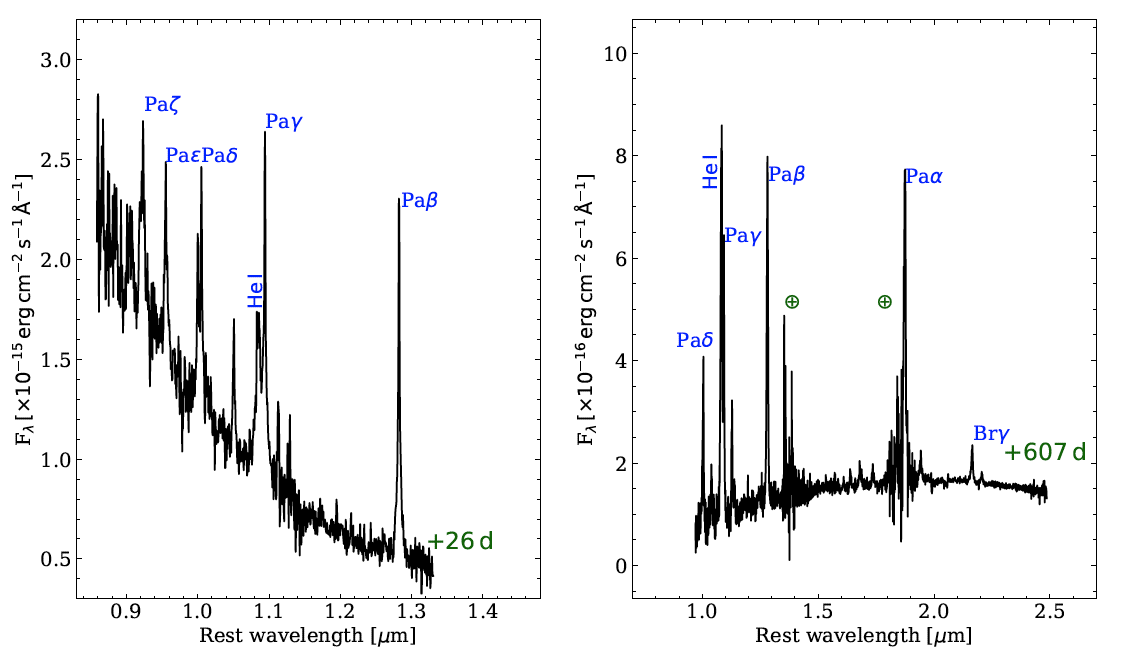When massive stars end their lives as core-collapse supernovae (CC SNe), their rapidly expanding ejecta may collide with their
dense circumstellar medium (CSM). As a consequence, the resulting conversion of kinetic energy to radiation may contribute
significantly to the total luminosity of the transient, depending on its efficiency. Strongly interacting supernovae are rare,
and a still poorly understood class of optical transients, although the interpretation of the physical mechanisms shaping their
CSM, as well as on the nature of their progenitors, is a crucial ingredient for our knowledge about massive stars evolution.
In addition, interacting supernovae are promising candidate sources of high-energy neutrinos and gamma rays, and have been
suggested as an important contributor to Galactic cosmic rays (CRs) beyond 1 Pev (Murase, Thompson & Ofek 2014, MNRAS, 440, 2528).
Efficient conversion of CRs into high-energy neutrinos and gamma rays is then expected to be mediated by the high ambient densities
through p-p or p-γ reactions (hadronic or leptonic mechanism, respectively), producing a predicted diffuse neutrino spectrum ranging
from 10 TeV to 1 PeV, at a flux level comparable to those reported by IceCube.
The most common interacting supernovae are characterized by spectra showing narrow lines in emission (with FWHM ranging from a few
100 to a few 1000 km/s) that are believed to arise in dense hydrogen (in SNe IIn) or helium-rich (in SNe Ibn) cocoons. This CSM was
lost by the progenitor star in the latest stages of its life (weeks to decades before the SN explosion) through stellar super-winds
or violent ejections similar to the ``Giant Eruption” experienced in the 19th Century by the Galactic luminous blue variable (LBV)
Eta Carinae.
Although enhanced mass loss can be produced via binary interaction, large eruptions in very massive stars can also generate dense
and massive circumstellar environments. In fact, a fraction of SNe IIn has been shown to be produced in the explosion of LBV stars
(e.g., Gal-Yam et al. 2009, Nature, 462, 624), whilst SNe Ibn are thought to be associated with Wolf-Rayet (WR) stars that experienced
major mass loss episodes a short time before their terminal explosion (e.g. Pastorello et al. 2007, Nature, 447, 829). Even more
interestingly, it has been shown that a growing number of interacting SNe have been heralded by major optical outbursts occurred weeks
to years before their explosion (see, the Giant LBV eruptions project). These pre-SN transients, in terms of energetics and spectral
appearance, may mimic a true SN explosion, and for this reason they have been named as ``SN impostors''.
Studying the multi-wavelength evolution of interacting SNe allows us to monitor the evolution of their spectral energy distribution (SED)
which may, occasionally, show infrared excesses due to newly formed dust, echoes, or reprocessing of light by pre-existing dust surrounding
their progenitor. The example of an ideal monitoring campaign of a Type IIn SN is given in Fig. 1.
Higher-resolution spectra (at least R>1000) are also required to detect fundamental features, such as narrow P Cygni profiles in their H or
He lines, which can be used to constrain wind expansion velocities, which can be used to derive physical quantities about the progenitor star
(e.g., an estimate of its mass-loss rate during the last evolutionary phases). Proper modeling of the ``electron scattering” profiles can be
used to infer wind expansion velocities even when absorption components are not visible due to particular physical and geometrical configurations
(see, e.g., Huang C., Chevalier R. A. 2018, MNRAS, 475, 1261).




Fig. 1 The outstanding follow-up campaign of SN 2015da. Optical (top left) and near-infrared (bottol-left) light curves.
Optical spectral sequence (top-right), and early (bottom-middle) and late (bottom-right) near-infrared spectra. The figures are
taken from Tartaglia et al. 2020, A&A, 635, A39).
Leading researchers: L. Tartaglia, A. Pastorello, N. Elias-Rosa, A. Reguitti, Y.-Z. Cai, I. Salmaso, E. Cappellaro.
Collaborators: M. Fraser, E. Callis, S. J. Brennan, R. Kotak, S. Moran, G. Pignata, K. Misra, M. T. Botticella, G. Pignata.
Publications:
- Tartaglia et al. 2021, A&A, 650, A174
- Fraser et al. 2021, submitted
- Tartaglia et al. 2021, ApJ, 907, 52
- Tartaglia et al. 2020, A&A, 635, A39
- Gangopadhyay et al. 2020, MNRAS, 499, 974
- Elias-Rosa et al. 2018, MNRAS, 475, 2614
- Kankare et al. 2017, Nature Astron., 1, 865
- Hosseinzadeh et al. 2017, ApJ, 836, 158
- Pastorello et al. 2016, MNRAS, 456, 853
- Benetti et al. 2016, MNRAS, 456, 3296
- Pastorello et al. 2015, MNRAS, 454, 4293
- Pastorello et al. 2015, MNRAS, 453, 3649
- Fraser et al. 2015, MNRAS, 453, 3886
- Pastorello et al. 2015, MNRAS, 449, 1954
- Pastorello et al. 2015, MNRAS, 449, 1941
- Pastorello et al. 2015, MNRAS, 449, 1921
- Inserra et al. 2014, MNRAS, 437, L51
- Fraser et al. 2013, MNRAS, 433, 1312
- Turatto & Pastorello 2013, IAUS, 296, 63
- Kankare et al. 2012, MNRAS, 424, 855
- Pastorello et al. 2011, AN, 332, 266
- Patat et al. 2011, A&A, 527, L6
- Trundle et al. 2009, A&A, 504, 945
- Agnoletto et al. 2009, ApJ, 691, 1348
- Mattila et al. 2008, MNRAS, 389, 141
- Pastorello et al. 2008, MNRAS, 389, 131
- Pastorello et al. 2008, MNRAS, 389, 113
- Zampieri et al. 2005, MNRAS, 364, 1419
- Benetti et al. 2006, ApJ, 653, L129
- Pastorello et al. 2005, ASPC, 342, 285
- Rigon et al. 2003, MNRAS, 340, 191
- Pastorello et al. 2002, MNRAS, 333, 27
- Di Carlo et al. 2002, ApJ, 573, 144
- Turatto et al. 2000, ApJ, 534, L57
- Benetti et al. 2000, MmSAI, 71, 323
- Aretzaga et al 1999, MNRAS, 309, 343
- Benetti et al. 1999, MNRAS, 305, 811
- Benetti et al. 1998, MNRAS, 294, 448
- Turatto et al. 1993, MNRAS, 262, 128